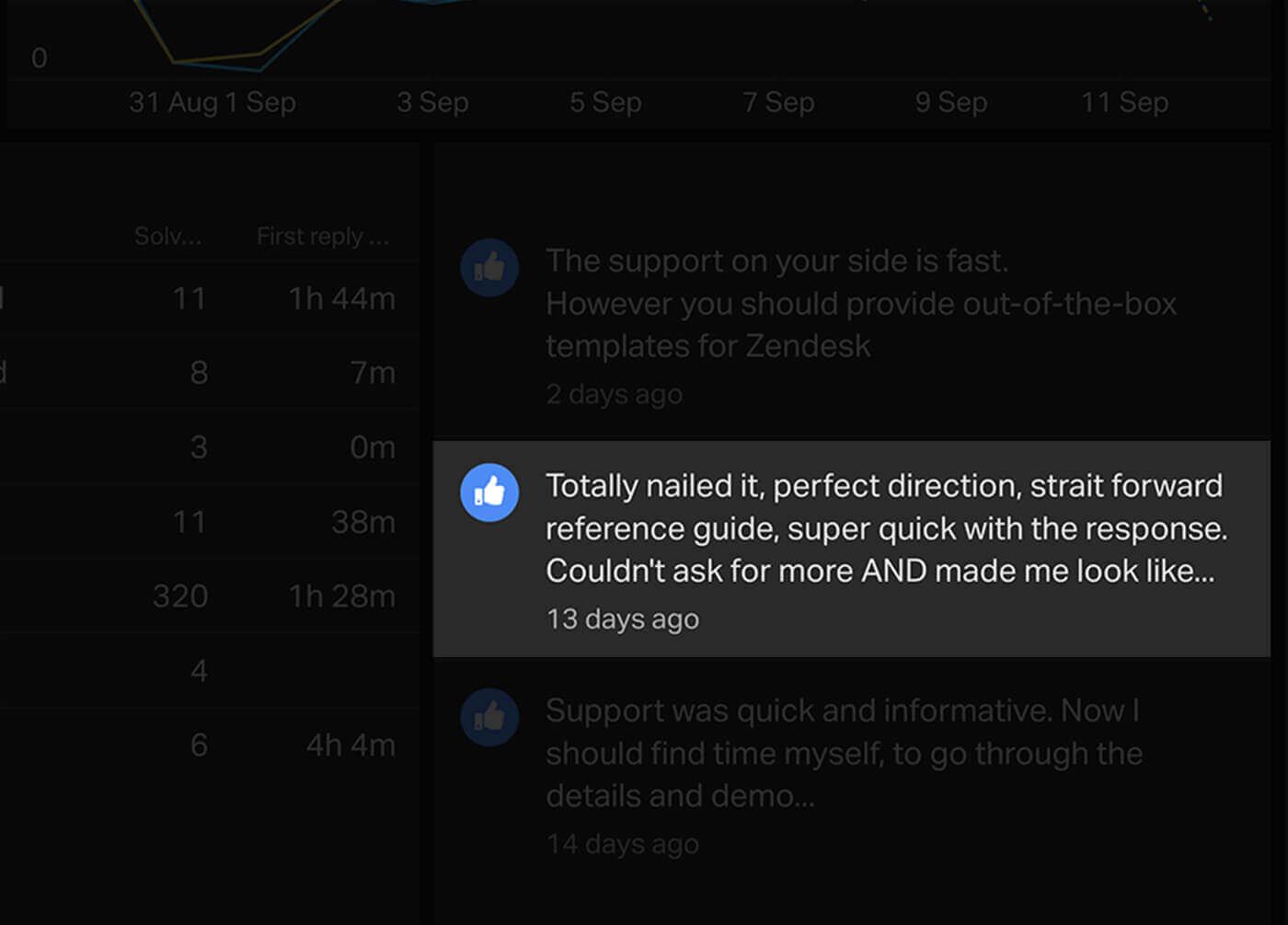Motivation is obviously essential for your team’s performance and happiness. And if your company needs any kind of creativity to survive then a certain type of motivation is more effective (spoiler: it’s the intrinsic one).
For this reason, most forward-thinking companies are moving away from traditional, extrinsic forms of motivation. But does this mean that "carrot and stick" is officially dead? Not quite.
To help you channel both types of drive in your team, we’ll give you practical tips that cover:
- The difference between intrinsic motivation and extrinsic motivation
- Which type of motivation is more effective and when
- How to nurture intrinsic motivation in your team
- How to use extrinsic motivation in a productive way
What's the difference between intrinsic motivation and extrinsic motivation?
Intrinsic motivation comes from within. It’s your natural drive to do something simply because you find it fun or you really care about it. You could call it your “mojo” (which would be pretty apt as the concept was coined by two radical psychologists in the 1970s).
Here are some examples of intrinsic motivation in a team:
- Writing an article for the company blog because they’re passionate about a subject
- Putting loads of effort into coding a feature because they enjoy solving software problems
- Starting a public-speaking course because they want to improve their presentations
In contrast, extrinsic motivation comes from someone or something outside of ourselves. And it’s triggered when we’re praised, rewarded, or put under pressure. In other words, it’s the old-school "carrot and stick" method.
Here’s what extrinsic motivation might look like in a team:
- Writing an article for the company blog because HR promised them an Amazon voucher
- Putting loads of effort into coding a feature because there’s the pressure of a deadline
- Starting a public-speaking course because their manager told them their presentations could be more engaging
Intrinsic motivation vs extrinsic motivation: which is better?
According to Daniel Pink’s Drive: The Surprising Truth About What Motivates Us, intrinsic motivation wins hands-down when it comes to creativity and innovation.
Just look at all the open-source software out there: the contributors aren’t paid a dime, yet dedicate thousands of hours, so what’s motivating them? Some German economists explored exactly that, and found that open-source developers are indeed mainly driven by intrinsic motivation: “the fun of mastering the challenge of a given software problem” and “the desire to give a gift to the programmer community.”
What’s more, extrinsic motivation has been shown to be ineffective and even harmful for creativity. A classic example of this was revealed in a psychological study of school kids, published in The Hidden Costs of Reward. In this, a set of kids were promised a reward for drawing pictures (an activity they enjoyed) while other kids weren’t promised anything for drawing pictures. Surprisingly, the kids who were promised and received a reward did less drawing than those who weren’t promised one. According to the psychologists, this happened because of The Sawyer Effect whereby the prospect of a reward turns something fun into a chore. And if you’re anything like Google with it’s slide-filled offices, this is the opposite of what you want. To spark creativity, you want work to have the qualities of play.
All this said though, the question of ‘which is better’ isn’t clear-cut. In specific situations, old-fashioned extrinsic motivation can still be effective. And even the psychologists who coined the term ‘intrinsic motivation’ agree that extrinsic motivation has its place. Really, it depends on the type of task, the team, and the individual.
Situations that benefit from extrinsic motivation
In every job, you occasionally have to do dull, repetitive tasks, like doing an audit of all your marketing content, or cold-emailing potential leads. And your team can’t be intrinsically motivated and excited about everything they do (unless you have a team of elves). For non-creative, methodical tasks, praise or rewards have been shown to be effective. You just have to be careful about how you praise and reward (which we’ll cover later).
Extrinsic motivation can also be helpful for certain types of team. For example, a sales team might be motivated by a leaderboard and bonuses which are both forms of extrinsic motivation. Whereas, a customer support team might be intrinsically motivated by making customers happy. In these cases neither type of motivation is better: it just comes down to the culture of the team.
Lastly, it’s important to consider the individual and ask your team what they’re interested in. What one person finds intrinsically motivating another might find incredibly dull — and vice versa. This is a great reason (amongst many) to strive for a neurodiverse team, and hire people with a mixture of different interests and ways of thinking.
How to nurture intrinsic motivation so your team can perform at their best
Intrinsic motivation is a curious beast, and it varies from person to person. But, according to Daniel Pink, there are three main things that everyone needs for intrinsic motivation to thrive. These things are: ‘autonomy,’ ‘mastery,’ and ‘purpose'.
First we’ll explore what these things mean for business, and then we’ll look at practical tips to harness each in your team.
Autonomy
Autonomy is when your team has a significant say in what they’re working on and how they should approach it. And ideally autonomy should be baked into your company’s culture. For this, you have to hire people who are naturally excited by their role and want to take ownership of it. You may even create the type of team structure — or aspire to one — that inherently lends itself to autonomy. For example, if you have a relatively flat structure then your team will have to be self-motivated and directed as they won’t have someone above to tell them what to do.
Aside from culture and structure, here are some major things that foster autonomy:
- Management By Objectives — first set out by Peter Drucker in the 1950s, MBO is where you tell your team the vision or overall objective, but give them the freedom to work out how to achieve it. And this relies on what Drucker calls ‘self-control,’ which is basically the same as intrinsic motivation
- Avoiding micromanagement — this is the opposite of autonomy which is why we’ve written a whole article on how to stop micromanaging
Purpose
To feel excited about their work, your team has to have a purpose. Firstly, they need to know what your company is all about, and what it wants to bring to the world. Then they need to know where they fit in and how they can help the company succeed.
Making these things clear to your team — and getting them on board — is one of your hardest jobs as a manager. It relies on you having a clear strategy and vision to start off with. It relies on your communication skills and charisma. It also relies on your ability to set clear and inspiring goals with your team.
Once you have these things in place, we think a TV dashboard is the best way to communicate your purpose.

A TV dashboard goes on your office wall where your team can see it. It makes key objectives clear, and unmissable for your team, which reinforces the company’s purpose and keeps it front of mind.
It also shows your team their impact on objectives, and makes them feel connected to the wider company. This gives them a sense of what Daniel Pink calls ‘relatedness’ which is crucial for intrinsic motivation.
Mastery
For your team, mastery means having opportunities to learn new and challenging things and get better at them. It helps them keep the long-term in mind instead of being limited to everyday tasks.
Here are some things that encourage mastery:
- An office library — this is an obvious way to encourage your team to read up on work-related topics that interest them. Also, by creating a comfy library area (beanbags obligatory for startups) you give your team “permission” to take time out from their everyday tasks, and think creatively about the company’s problems
- Innovation Days — some software companies take the “20 percent approach” where they encourage teams to spend twenty percent of their time on a company problem that’s not part of their everyday work. At Geckoboard we do something similar, with five Innovation Days every quarter and a company-wide Innovation Week every year. This gives people the opportunity to break their routine, learn from different people, and master something new
- A development budget — if you can, give each team member a personal-development budget to spend on work-related courses that interest them. This makes it clear that you want them to take on new challenges, whilst giving them a practical way to actually do so
How to use extrinsic motivation productively
“Stick” (punishment, or the threat of something negative) is very much dead as a form of motivation. But, as we said earlier, a little bit of “carrot” (reward) can still be helpful in specific situations.
To help you reward your team in the best way, and stop it from stifling intrinsic motivation, here are some tips:
Make sure praise is specific, genuine, and encourages autonomy
According to the psychologist Edward L. Deci (mentioned in Drive: The Surprising Truth About Motivates Us) “positive feedback can have an enhancing effect on intrinsic motivation.”
To encourage autonomy, and avoid using praise as a form of micromanagement, Daniel Pink advises:
Don’t tell the design team: “That poster was perfect. You did it exactly the way I asked.” Instead, give people meaningful information about their work. The more feedback focuses on specifics (“great use of color”) — and the more the praise is about effort and strategy rather than about achieving a particular outcome — the more effective it can be.
Daniel Pink
Tailor praise and positive feedback to your team
Some people will feel awkward getting praise in front of others, while other people will thrive on this. Think what’s best for the individual.
Also, do your “research” and make sure you’re giving credit to the right people. Praising one person instead of a whole group for something they achieved jointly could negatively impact the person you’re praising and upset the rest of the group.
As for constructive feedback, it’s of course crucial for your team’s performance, but again your approach depends on the team.
Some teams might respond well to the style of feedback in Kim Scott’s Radical Candor (others not so much). Her stances are pretty controversial, but we totally agree with her stance on the praise-to-criticism ratio:
Some professionals [...] advocate the “feedback sandwich” — opening and closing with praise, sticking some criticism in between. I think venture capitalist Ben Horowitz got it right when he called this approach the “shit sandwich.” Horowitz suggests that such a technique might work with less-experienced people, but I’ve found the average child sees through it just as clearly as an executive does.
Kim Scott
Consider a TV dashboard for reward and recognition
Sometimes the wider company isn’t aware of your team’s achievements so they don’t get recognition.
This is another thing our TV dashboards can help with. For example, you could share positive customer feedback for the Customer Support team on your dashboard:

The idea of this is to give team-members a sense of achievement, and hopefully get them recognition from the rest of the company.
You could also add a leaderboard to give star performers a buzz and bring out a bit of healthy competition. Or, you could give the whole team a collective sense of achievement with progress indicators:

Give rewards and bonuses after the event
When it comes to creativity, Daniel Pink argues that it’s better to give the reward after the activity. If you offer it beforehand, it can turn creative activities into chores, and become the sole objective for doing something.
Also, if rewards are given out all the time they become the expected thing, and your team might feel disappointed if they don’t get one.
For this reason “surprise-and-delight” style rewards are good, like a team lunch, the afternoon off, or something more personal to your team-member.
Be careful about tying rewards and bonuses to key objectives
If you do offer rewards for hitting specific goals, here’s how to stop these rewards from being counter-productive:
- Watch out for ‘gaming’ — if teams are offered a reward for hitting a particular goal, then it’s tempting to hit that goal in an underhand way. For example, if a customer support team were offered a reward for reducing Average Hold Time they might be tempted to rush calls for the sake of it. This kind of thing is called a perverse incentive or Cobra Effect, and you just need to be mindful that it can happen
- Keep reminding your team of the overall purpose — this will stop them from being too myopic and focusing on that one goal to the detriment of the bigger picture. For example, in the customer support case above, you could remind your team that the overall purpose was to improve Customer Satisfaction by displaying CSAT on a dashboard. This is an example of a health metric
- Don’t tie rewards to revenue, unless it’s a sales team — it’s hard to measure the monetary impact of other types of teams, so a reward linked to revenue would actually be demotivating for them. Instead, you want to give your team objectives that they can actually influence.
For more advice on this, see our article on how to set meaningful and effective KPIs.
In summary
- Intrinsic motivation is generally more effective than extrinsic motivation. Especially when it comes to creativity and innovative thinking
- "Carrot" (reward) can be an effective form of motivation for repetitive tasks, and certain teams. The most important thing is to give any rewards after the activity so it doesn’t crush creativity
- "Stick" (punishment) is far less effective at motivating teams than "carrot" and intrinsic motivation
Extra reading
The psychology of motivation is obviously really important for your business, but it’s fascinating to read about generally. Here are the books we’ve mentioned in this article:
- Drive: The Surprising Truth About What Motivates Us by Daniel. H. Pink — a clarion call for intrinsic motivation, with proof from neuroscience and examples from business
- The Practice of Management by Peter F. Drucker — this book paved the way for modern management, and “got” the idea of intrinsic motivation long before the term was invented
- The Hidden Costs of Reward by Mark R. Lepper and David Greene — these psychologists were some of the first to discover that traditional incentives can actually be damaging for motivation
- Radical Candor by Kim Scott — the former director at Google advises on how to give frank feedback without demotivating your team

